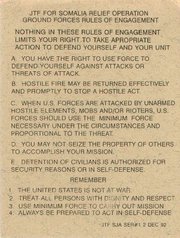Rules of engagement
|
|
This article describes the military term of the rules of engagement. For information about the movie with the same name see Rules of Engagement (movie).
In military or police operations, the rules of engagement (ROE) determine when, where and how force shall be used. Such rules are both general and specific, and there have been large variations between cultures throughout history.
The US Department of Defense officially defines ROE as:
- "Directives issued by competent military authority which delineate the circumstances and limitations under which United States forces will initiate and/or continue combat engagement with other forces encountered." [1] (http://www.tpub.com/content/USMC/mcwp323/css/mcwp323_76.htm)
The ROE deal with four issues [2]:
- When military force may be used,
- Where military force may be used,
- Against whom force should be used in the circumstances described above, and
- How military force should be used to achieve the desired ends.
The ROE take two forms: Actions a soldier may take without consulting a higher authority, unless explicitly forbidden (sometimes called 'command by negation') and second, actions that may only be taken if explicitly ordered by a higher authority (sometimes called 'positive command').
In addition to a typically large set of standing orders, military personnel will be given additional rules of engagement before performing any mission or military operation. These can cover circumstances such as how to retaliate after an attack, how to treat captured targets, which territories the soldier is bound to fight into, and how the force should be used during the operation.
The ROE are extremely important:
- They provide a consistent, understandable and repeatable standard on how forces act. Typically they are carefully thought out in detail well in advance of an engagement and may cover a number of scenarios, with different rules for each.
- They assist in the synchronization of political-diplomatic and military components of a strategy by allowing political commanders to better understand, forecast and tailor the actions of a force.
The first rule of engagement for United States military forces is always the right to use force in self-defense.
ROE failures
In any engagement, the ROE need to balance two competing goals: The need to use force effectively to accomplish the mission objectives and the need to avoid unnecessary force. This creates room for two types of error:
- Excessively tight ROE can constrain a commander from performing his mission effectively, called a Type I error. It is typical for the political leadership to constrain the actions of military commanders. This is often a source of tension between the political leaders, who are trying to accomplish a wider objective and the military commanders, who are trying make the most effective use of their forces. Sagan [2] provides an excellent discussion of this topic.
- Excessively loose ROE can facilitate the escalation of a conflict which, while being tactically effective, negates the political objectives that the use of force was meant to achieve. This is a Type II or 'escalatory' error.
Current Issues
(2004) There is an increase in the use of Private Military Companies (PMC's) in modern conflict. Typically these companies are not bound by the same ROE and well thought out standing orders that a national military force adheres to. Nor are they typically as accountable. This increases the likelihood of Type II errors.
See also:
Rules of Engagement (movie) - Hollywood drama centering on ethical and political implications of ROE
References
- USDOD. DOD Dictionary of Military and Associated Terms: NATO Only Terms (http://www.dtic.mil/doctrine/jel/doddict/natoterm_index.html). United States of America: Joint Doctrine Division, J-7, Joint Staff, Department of Defense. December 17, 2003.
- Sagan, Scott D., Rules of Engagement, pp 443 - 470 in: George, A., Avoiding War: Problems of Crisis Management, ISBN 0-8133-1232-9. This well written analysis provides an excellent overview.
- Private Military Companies, Taljaard, R. Yale Global Online 9 December 2003.Modern Day Mercenaries (http://www.sandline.com/hotlinks/Yale_Modern-day-mercs.html).

